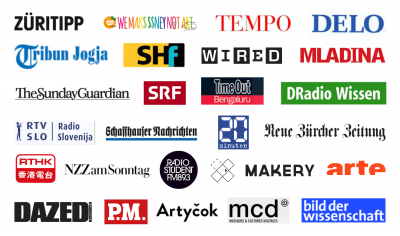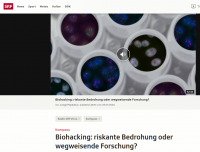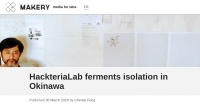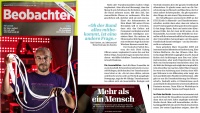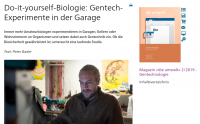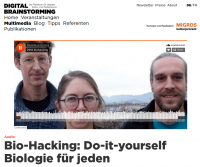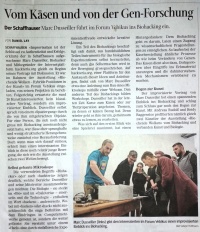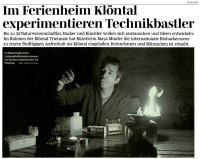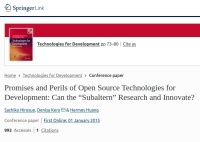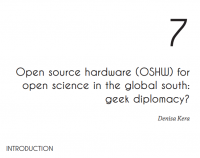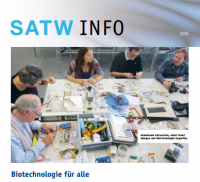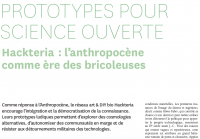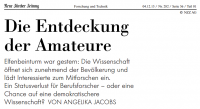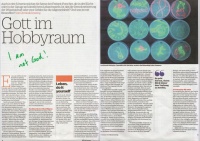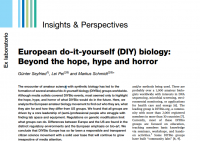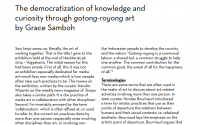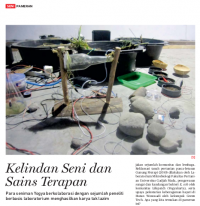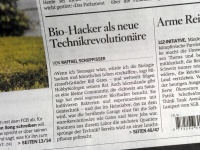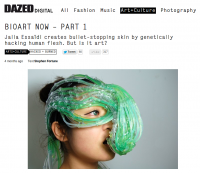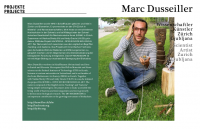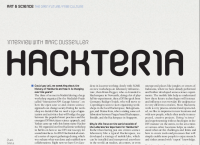Press Coverage
Below you find a selection of the most relevant publication and media articles about hackteria. You can also scroll through the media blog posts on the hackteria website
Contents
- 1 2022
- 2 2020
- 3 2019
- 4 2018
- 5 2017
- 5.1 Vom Käsen und von der Gen-Forschung, Schaffhauser Nachrichten 21. November 2017, Daniel Lay
- 5.2 Bastler, Bakterien und Beerensaft, Sonntagszeitung 1. Oktober 2017, Anke Fossgreen
- 5.3 Bio-Hacker im Klöntal, TV Südostschweiz, September 2017
- 5.4 Im Ferienheim Klöntal experimentieren Technikbastler, Südostschweiz / Ausgabe Glarus, September 2017
- 6 2016
- 7 2015
- 7.1 Promises and Perils of Open Source Technologies for Development: Can the “Subaltern” Research and Innovate?, Hirosue, S., Kera, D., Huang, H.
- 7.2 Open source hardware (OSHW) for open science in the global south: geek diplomacy?, Denisa Kera
- 7.3 Biotechnology for All / DIY in bioanalytics: doing and grasping it yourself. SATW publication 2015
- 7.4 ”Prototype pour science ouverte” by D. Kera in MCD#79, 2015
- 7.5 "Die Entdeckung der Amateure" - NZZ, 04. Dez 2015, by Angelika Jacobs
- 8 2014
- 8.1 “Gott im Hobbyraum” – NZZ am Sonntag, 19. Okt 2014, by Dominik Imseng
- 8.2 European do-it-yourself (DIY) biology: Beyond the hope, hype and horror, Günter Seyfried et. al. BioEssays, Volume 36, Issue 6, June 2014
- 8.3 The democratization of knowledge and curiosity through gotong-royong art, by Grace Samboh, 2014
- 8.4 Kelindan Seni dan Sains Terapan, Majalah Tempo, May 2014, Hendro Wiyanto
- 9 2013
- 9.1 Hackteria: An example of neomodern activism. Leonardo Online 2013, Boris Magrini
- 9.2 Zu Besuch bei den Biohackern , Schweiz am Sonntag, Nr. 18, 5. Mai 2013 , R. Schuppisser
- 9.3 Dazed & Confused: BIOART NOW: August 2013, S. Fortune
- 9.4 Home Made Bio Electronic Arts Do-it-yourself: Microscopes, Sensors, Sonifications - Christoph Merian Verlag / Migros-Kulturprozent: Dominik Landwehr, Verena Kuni (Ed.), 2013
- 10 2012
- 11 2011
2022
Podcast: “Art meets biohacking” with Yashas and Sachiko, by Pro Helvetia «Art, Science and Technology» podcast
In this episode, Indian artist Yashas Shetty and Japanese bioengineer Sachiko Hirosue share a dialogue on their interest in critical territories where science intersects with society. They discuss the Scientist-in-Residency programme as well as bio-design and the Hackteria project on which they both collaborated. Their work together aims to understand and explore the artistic, social and political implications of technologies, creating spaces of dialogue and interaction between artists, designers and scientists.
Indian artist Yashas Shetty founded Hackteria back in 2009, together with Marc Dusseiller and Andy Gracie. Hackteria is a repository for Open Source Biohacking material, accessible to both scientists and artists. Pro Helvetia supported Yashas Shetty’s research trip to Switzerland in 2013, to continue his collaboration with Marc Dusseiller and the International Hackteria Society.
Sachiko Hirosue is a bioengineer, primarily interested in critical territories where science intersects with society. In practice, this translates to creating alternative spaces in dominant cultures to approach science and technology differently. In 2014, Dr. Sachiko Hirosue took part in HLab14, a project funded by Pro Helvetia. It was an immersive collaborative production workshop of interdisciplinary Swiss artistic research, bringing together artists, researchers, educators, and designers to work on issues of the local environment in Yogyakarta, Indonesia.
https://www.hackteria.org/media/podcast-art-meets-biohacking/
"SYMBIOTIC ART - What is BioArt?", by Claire Pentecost, ARTnews, Art in America, 2.3.2022
NEW FORMS OF COOPERATION have opened up the whole field of biology, especially for artists. Along with the GFP bunny, the year 2000 also saw the launch of SymbioticA, a visionary research lab dedicated to artistic inquiry in the life sciences. Hosted by the University of Western Australia, the lab is the brainchild of artist-researchers Oron Catts and Ionat Zurr. It was the first of numerous similar ventures that render the methods and technology of biologic study transparent and accessible. Most subsequent examples are likewise affiliated with educational institutions: the Coalesce BioArt Lab at SUNY Buffalo, Biofilia at Aalto University in Finland, Suzanne Anker’s Bio Art Lab at the School of Visual Arts in New York, and New York University’s WetLab. The past decade has also seen a proliferation of DIY open access labs, like Genspace in Brooklyn; Counter Culture Labs in Oakland, California; Incubator Art Lab at the University of Windsor, in Canada; and Baltimore Underground Science Space (BUGSS), to name just a few. The trend extends online: Hackteria.org is a global network of open-source community platforms connecting individuals who share an interest in hacking living systems. All these undertakings are intensively transdisciplinary, encompassing scientists, artists, technology buffs, and people from many other walks of life. In addition to providing access to equipment, specialized knowledge, and the opportunity to experiment, they are alive with the ethical debates inherent to any endeavor that involves living tissue and DNA.
One of the main tenets of science and technology studies is that labs are cultural spaces. Community biology facilities are deliberately and self consciously social. Participants are hacking the exclusivity of expertise. Individual artists, too, have taken up “workshopology,” as Hackteria calls it. Mary Maggic, for instance, has built an accessible sphere around biohacking estrogen, and has also made work concerning hormone disrupting chemicals in the environment.
https://www.artnews.com/art-in-america/features/what-is-bio-art-1234620687/
2020
"Biohacking: riskante Bedrohung oder wegweisende Forschung?", by Jan Gross, Kompass - SRF Virus, 28.09.2020
Fluoreszierende Mäuse, verbotene Experimente und implantierte Chips – wenn es nach Hollywood geht, sind Biohacker durchgeknallte Hobby-Biolog*innen oder fiese Bösewichte. In der Hintergrundsendung «Kompass» klären wir auf, wie es in Realität aussieht und was wirklich hinter der Bewegung steckt.
Das Wichtigste in Kürze
- Bei «Biohacking» (auch DIY-Biologie) handelt es sich um eine Bewegung von Hobby-Biolog*innen, die ausserhalb von Universitäten und Institutionen stattfindet. Im Zentrum steht die unabhängige, private Forschung in provisorisch eingerichteten Laboren mit selbstgebauten Geräten. Seinen Ursprung hat «Biohacking» im amerikanischen Cambridge. Richtig aufgekommen ist es Mitte der 2000er-Jahre.
- «Hacking» beschreibt die innovative und neue Anwendung von bestehenden Technologien (z.B. ein Toaster, der zu einer Kaffeemaschine umfunktioniert wird). «Bio» steht für Biologie und umfasst die drei Teilbereiche Laborexperimente, Bodyhacking (Optimierung des eigenen Körpers) und Genkunst.
- Neben der Forschung spielt der Aspekt des Selbermachens (z.B. von Laboreinrichtungen und -geräten) sowie das Teilen und Verbreiten des Wissens («Open Source») eine wichtige Rolle.
- Die Schweizer Szene ist zwar klein, im globalen Kontext aber nicht unbedeutend: Insgesamt wird sie auf zehn Labore und 50 bis 100 Biohacker*innen (exkl. Bodyhacking) geschätzt.
"Reports on Oki Wonder Lab", by Cherise Fong, Makery
"HackteriaLab ferments isolation in Okinawa", by Cherise Fong, Makery, 30. March 2020
https://www.makery.info/en/2020/03/30/english-hackterialab-ferments-isolation-in-okinawa/
Oki Wonder Lab just may be the most remote un-disciplinary DIYbio research camp going on in the world right now. Hackteria’s latest large-scale event is currently taking place in the Japanese archipelago of Okinawa.
"Oki Wonder FoodLabs tantalize the senses", by Cherise Fong, Makery, 7. April 2020
https://www.makery.info/en/2020/04/07/english-oki-wonder-foodlabs-tantalize-the-senses/
As Oki Wonder Lab gleefully camps out in Okinawa, most Hackterians are stuck indoors. An online KitchenLab hosted live from Helsinki offered an entertaining glimpse of localized baking, while other experiments are fermenting and distilling across the global network.
2019
'Mehr als ein Mensch' Beobachter, Nils Hänggi, Nov 2019
CYBORGS. Transhumanisten planen die Mensch-Maschine. Mit implantierter Technik wollen sie die Biologie verbessern.
"Die Auserwählten. Auch für Marc Dusseiller ist es ein Geschäft. Er bezeichnet sich als Do-it-yourself-Biologen, als Biohacker. Den Transhumanismus lehnt er ab. «Es ist eine elitäre, extrem unkritische und zu sehr auf Technik ausgelegte Bewegung», sagt der 44-Jährige. Transhumanisten sähen sich als Auserwählte. Biologie und Technik müssten aber der ganzen Gesellschaft offenstehen. Er glaubt zwar auch an die Verschmelzung von Mensch und Maschine, doch er setzt andere Schwerpunkte. «Es gibt spannendere Dinge, als mir einen Chip einzusetzen.» ... Dusseiller will die wissenschaftliche Forschung aus den Universitäten heraustragen und die ganze Gesellschaft daran beteiligen – um das Gemeinwohl zu verbessern."
"Im Visier des Bunds. Inzwischen interessiert sich auch der Bund für Dusseillers Ansatz und führt dazu eine auf zwei Jahre angelegte nationale Studie durch. Man will herausfinden, ob Biohacking gefährlich ist und der Bund einschreiten muss. Die ersten Ergebnisse zeigten, dass die Szene ungefährlich sei, sagt Basil Gerber, stellvertretender Sektionschef Biotechnologie. «Biohacker führen kleine Experimente durch. Und sie machen sich durchaus Gedanken um ihre Experimente. Ob der Bund aber alles mitbekommt, ist natürlich die andere Frage.»"
Download full article: File:Reportage_Mehr als ein Mensch.pdf
"Do-it-yourself-Biologie: Gentech-Experimente in der Garage" BAFU Magazin «die umwelt» 2/2019 - Gentechnologie
Am Ende des Gesprächs muss die Frage doch noch gestellt werden: «Sind Sie eigentlich ein Rebell?» Ja, antwortet Marc Dusseiller, ohne zu zögern, das könne man schon sagen. Dies hört sich ein bisschen gefährlicher an, als es tatsächlich ist. Es bedeutet: Der 43-jährige Schaffhauser beschreitet aussergewöhnliche Wege. Er promovierte in Material- und Nanobiowissenschaften und absolvierte danach ein Postdocstudium in Robotik. Weil er «immer sehr an der interdisziplinären Arbeit interessiert» war, konnte sich Marc Dusseiller eine klassische Forscherkarriere mit engem Themenspektrum nicht vorstellen. Er verliess die Universität 2006 und arbeitet seither als freischaffender Dozent und Veranstalter von Workshops. Er experimentierte zudem mit elektronischer Musik und wurde Mitbegründer der Schweizerischen Gesellschaft für Mechatronische Kunst (SGMK) in Zürich.
Direkt zum Artikel "Do-it-yourself-Biologie: Gentech-Experimente in der Garage"
2018
Bio-Hacking: Do-it-yourself Biologie für jeden Digital Brainstorming podcast moderated by Dominik Landwehr
Ist es möglich, die Ideen von Do-it-yourself, Hacking und Open Culture von der Computerwissenschaft auf die Biologie zu übertragen? – Ja sagen die Biohacker: Die Öffentlichkeit hat ein Recht, Methoden dieser Wissenschaften zu kennen und selber auszuprobieren, das gilt auch für die Gentechnik und ihre allerneusten Methoden wie CRISPR. Seit über zehn Jahren machen Biohacker von sich reden, auch in der Schweiz. Grund genug für ein Update: Im Gespräch mit Dominik Landwehr diskutieren neben dem Schweizer Biohacking Pionier Marc Dusseiller die Wissenschaftsvermittlerin Lucy Patterson sowie der Zürcher Wissenschaftsjournalist Roland Fischer. Das Gespräch fand am 13.Januar 2018 in Zürich statt.
https://www.digitalbrainstorming.ch/de/multimedia/audio/biohack
2017
Vom Käsen und von der Gen-Forschung, Schaffhauser Nachrichten 21. November 2017, Daniel Lay
«Improvisation ist der Schlüssel zu Authentizität und Erfolg», erklärte der in Schaffhausen aufgewachsene Marc Dusseiller, Biohacker und Mitbegründer der Internetplattform hackteria.org gleich zu Beginn seines Vortrags mit Diskussion. Er war im Rahmen der Ausstellung «Riechende Wolken – Hybride Positionen in der Kunst» im Forum Vebikus eingeladen, von seinen Projekten zu berichten.
Bastler, Bakterien und Beerensaft, Sonntagszeitung 1. Oktober 2017, Anke Fossgreen
Biohacker nutzen die Gentechnik, tüfteln an Elektrogeräten oder fermentieren Lebensmittel. Sie sind untereinander vernetzt und teilen ihre Forschungsergebnisse miteinander
Labor in Küche, Keller und Garage
Wer als Hobby mit Bakterien oder DNA hantieren möchte, benötigt eine Grundausstattung. Freizeitforscher bauen sich ihre Laborgeräte selber, bestellen ausrangierte Versionen über Ebay oder improvisieren. Beispielsweise kann ein Dampfkochtopf zum Sterilisieren verwendet werden oder ein umgebauter Reiskocher. Ein günstiges Mikroskop lässt sich aus einer Webcam basteln. Ein einfaches Experiment ist, die eigene DNA aus der Mundschleimhaut zu extrahieren. Man benötigt: Spucke, Spülmittel, Kontaktlinsenreiniger, Salz und hochprozentigen Rum. Wer hingegen Bakterien verändern möchte, braucht molekularbiologisches Zubehör, etwa Enzyme, die DNA zerschneiden oder eventuell eigens hergestellte Gensequenzen, die Firmen auf Bestellung zusammensetzen. Wichtig ist, dass Mensch, Tier und Umwelt nicht durch das Experiment gefährdet werden, eine Anforderung von Gentechnik- und Umweltschutzgesetz. Wer seine Versuche und das Heimlabor bei der Kontaktstelle Biotechnologie des Bundes anmeldet, kann legal loslegen. Tipps und Anleitungen liefern die Biohacker.
File:Biohacker_SZ_S_62_63-2017-10-01.pdf
Bio-Hacker im Klöntal, TV Südostschweiz, September 2017
https://www.suedostschweiz.ch/sendungen/2017-09-21/bio-hacker-im-kloental
Im Rahmen der Triennale Klöntal treffen sich zurzeit rund 20 Bio-Hacker. Wir von TV Südostschweiz waren mit der Kamera zu Besuch, um zu schauen, was diese Leute so aushacken.
Im Ferienheim Klöntal experimentieren Technikbastler, Südostschweiz / Ausgabe Glarus, September 2017
Bis zu 50 Naturwissenschaftler, Hacker und Künstler wollen sich austauschen und Ideen entwickeln: Im Rahmen der Klöntal Triennale hat Künstlerin Maya Minder die internationale Biohackerszene zu einem fünftägigen Aufenthalt ins Klöntal eingeladen. Reinschauen und Mitmachen ist erlaubt.
File:Zeitung_Sudostschweiz_BHRK17.pdf
2016
Makery: Marc Dusseiller, Biohack Pioneer & Coconut Researcher 2016
Long and two part interview by Ewen Chardronnet for Makery done during Interactivos?16, June 2016, published in French and English in July 2016
Part 1 Marc Dusseiller, biohack pioneer: This summer, we’re traveling with Swiss globetrotter Marc Dusseiller, who cofounded Hackteria, the international open source network of biohackers and bioartists. In this first part, the ex-researcher in nanotechnology talks about how the DIYbio movement came to Europe and founding Hackteria in India in 2009.
Marc Dusseiller, biohack pioneer (1/2)
Part 2 How to (not) innovate with a coconut: Marc Dusseiller, co-founder of the DIYbio network Hackteria, is a passionate promoter of open hardware. This is all the more evident in part 2 of our interview, where the activist scientist talks about the DIY microscope and the propaganda of innovation, which led him to create the Center for Alternative Coconut Research.
How to (not) innovate with a coconut (2/2)
SRF Einstein - Der Wissenschafts-Rebell: Bio-Hacker Marc Dusseiller, Feb 2016
Marc Dusseiller hat seine erfolgreiche Forscherkarriere hingeschmissen und ist Biohacker geworden. Er experimentiert in seinem Heimlabor, verbindet Wissenschaft und Kunst und will damit die breite Masse für die Biologie begeistern. Der Querdenker bewegt sich zwischen Anarchismus, Kunst und Wissenschaft. «Einstein» zeigt in einem Portrait wie der Biohacker Würste zum Leuchten bringt und gibt Einblick in die noch junge Bewegung der „do it yourself“-Biologie.
http://www.srf.ch/sendungen/einstein/das-dada-prinzip-in-der-wissenschaft
Synthetische Biologie – die nächste Stufe der Bio- und Gentechnologie, TAB-Arbeitsbericht für den Deutschen Bundestag, Feb 2016
- Wissenschaftliche und technologische Fortschritte ermöglichen einen zunehmend tiefer greifenden genetischen Umbau natürlicher Organismen (Synbio i. w. S.), perspektivisch wird die Schaff ung künstlicher biologischer Systeme (Synbio i. e. S.) anvisiert.
- Anwendungsbereiche liegen in der Chemie- und Energieproduktion, in der Medizin und im Umweltschutz. Welche Ansätze der Synbio sich durchsetzen werden gegenüber Verfahren, die die vorhandene biologische Vielfalt nutzen oder sich auf subtile Eingriffe beschränken, ist beim heutigen Stand von Forschung und Entwicklung nicht verlässlich prognostizierbar.
- Für die Risikoabschätzung und -bewertung substanziell veränderter Organismen müssen neue Methoden und Verfahren entwickelt und erprobt werden.
- Die Partizipationsmöglichkeiten der Gesellschaft an einer verantwortungsvollen Weiterentwicklung der Synbio reichen von einer Stakeholderbeteiligung an der Forschungsprogrammatik bis zur DIY-Biologie.
- Der Umgang mit geistigem Eigentum unter den Bedingungen einer zunehmend digitalen Ökonomie stellt eine der zentralen Zukunftsherausforderungen auch für die Nutzung der Synbio dar.
Direct Link to Büro für Technikfolgen-Abschätzung beim Deutschen Bundestag
Summary in English on Hackeria.org
2015
Promises and Perils of Open Source Technologies for Development: Can the “Subaltern” Research and Innovate?, Hirosue, S., Kera, D., Huang, H.
The paper summarizes the current state of the “Openness Paradigm” for development, with a focus on open source hardware and the related issues of open science, open data, and open access. It focuses on how such efforts support more equal collaborations between North and South on open science and citizen projects. It also discusses these efforts as an example of an inclusive Research and Development (R&D) agenda different from the traditional practice of technology transfer, which enforces the hierarchical notion of “development.” We apply the present postcolonial studies discourse along with contemporary discussions in the west on public participation in science, as a framework to discuss Technology for Development (Tech4Dev). Thus, bringing attention to nontraditional formats and institutions, and new institution–community relations, as examples of a more democratic and inclusive Tech4Dev agenda.
http://link.springer.com/chapter/10.1007/978-3-319-16247-8_7
Download: File:2015_HirosueKeraHuang_OpenSource_forDev.pdf
Open source hardware (OSHW) for open science in the global south: geek diplomacy?, Denisa Kera
The Do-It-Youself biology (DIYbio) movement originated in the U.S. in approximately 2009 around student iGEM synthetic biology competitions as well as parallel open biology efforts in Europe and Asia with their connections to bioart and critical science practices in the late 1990s. This movement merged in recent years with other movements coming from professional scientists advocating eScience, Open Science, Open Access and Open Data. The calls for changing the publishing model and opening the datasets while supporting online collaboration and crowdsourcing are starting to merge with attempts to reduce the cost of experimental research and increase reproducibility by building low cost customizable laboratory equipment.
File:Open Science 2015 Kera GeekDiplomacy.pdf
http://hackteria.org/media/oshw-geek-diplomacy/
Biotechnology for All / DIY in bioanalytics: doing and grasping it yourself. SATW publication 2015
SATW Info 2/15 – Biotechnology for all / DIY in bioanalytics: doing and grasping it yourself. More info here.
«Do it yourself» in der Bioanalytik – für Deutsch siehe hier, français ici.
The article from SATW Info 2/15 – Biotechnology for all / DIY in bioanalytics: doing and grasping it yourself is available for download in German, English and French. The pedagogic conecpt and educational kits were developed during a project funded by the Swiss Academy for Engineering Sciences (SATW), together with hackteria, M. Dusseiller and U. Gaudenz, and FHNW School for Lifesciences, Dr. D. Gygax, during a workshop with an interdisciplinary group of participants.
"Biotechnological research is no longer limited to specialist laboratories: a growing community of biologists, amateur enthusiasts and technophiles is experimenting in kitchens, workshops and DIY laboratories. Some people view the democratisation of biotechnology as a threat, others as an opportunity to gain a better understanding of complex scientific interrelationships within society."
"Biotechnologische Forschung findet heute nicht mehr nur in spezialisierten Labors statt. Eine wachsende Gemeinschaft von Biologen, Bastlern und Technikbegeisterten experimentiert in Küchen, Werkstätten und Eigenbau-Labors. Einige sehen in der Demokratisierung der Biotechnologie eine Gefahr; andere die Chance für ein besseres Verständnis von komplexen wissenschaftlichen Zusammenhängen in der Gesellschaft."
"Aujourd’hui, la recherche biotechnologique n’est plus l’apanage des laboratoires spécialisés. Une communauté croissante de biologistes, de bricoleurs et de passionnés de technique s’adonne à des expériences dans des cuisines, des ateliers et des laboratoires individuels. Certains considèrent cette démocratisation de la biotechnologie comme un danger, d’autres comme une chance d’améliorer la compréhension des relations scientifiques complexes au sein de la société."
”Prototype pour science ouverte” by D. Kera in MCD#79, 2015
The recent edition of MCD#79 – Nouveaux récits du climat, invited editors Ewen Chardronnet and Julien Bellanger, has now been published in French, stay tuned for the English version. It showcase a collection of articles on topics of climate and art, the anthroposcene and activism by invited authors such as Alexandra Daisy Ginsberg, Donna Haraway, Marko Peljhan amongst many others.
“Anthropocene as the Age of the Tinkerers: Hackteria Open Science Prototypes”
Denisa Kera, in discussion with Marc Dusseiller, Urs Gaudenz and Paula Pin, wrote a nice article about the most recent developments and activities in the global hackteria network.
Hackteria’s response to the anthropocene are open science prototypes, which support inclusion and democratization of knowledge. Instead of a TED talk grand narratives of the homo faber, who will save the world with the next technological intervention, Hackteria homo ludens builds playful prototypes to explore alternative cosmologies, empower niche communities, and resist military misuses of technologies.
http://hackteria.org/media/prototype-pour-science-ouverte-mcd79/
"Die Entdeckung der Amateure" - NZZ, 04. Dez 2015, by Angelika Jacobs
Elfenbeinturm war gestern: Die Wissenschaft öffnet sich zunehmend der Bevölkerung und lädt Interessierte zum Mitforschen ein. Ein Statusverlust für Berufsforscher – oder eine Chance auf eine demokratischere Wissenschaft?
«Da liegt ein generelles Problem, was man unter dem Begriff Wissenschafter versteht», sagt Muki Haklay, der CoLeiter der Gruppe «Extreme Citizen Science» am University College London. Zum Beispiel gebe es in biologischen Laboren meist ein hierarchisches Denken, das zwischen Laboranten und den «echten» Forschern unterscheide. Obwohl die Forscher manchmal die Experimente ohne die Laboranten gar nicht bewerkstelligen könnten.
Auch Marc Dusseiller benutzt nicht gern den Begriff «Bürgerwissenschaft». «Auch jeder, der an einer Hochschule arbeitet, ist ein Bürger.» Lieber spricht er von «unabhängiger Forschung». Der ausgebildete Nanotechnologe lehrt zwar noch an Hochschulen, forscht aber nur noch – eben: unabhängig. Für das Netzwerk Hackteria reist er um die Welt und bietet Do-it-yourself Wissenschafts-Workshops an, in denen er mit den Teilnehmern Laborgeräte mit einfachsten Mitteln baut. Einer seiner Klassiker: ein Mikroskop aus einer Webcam basteln. Durch solche Tüfteleien wolle er die Wissenschaft und ihre Geräte entmystifizieren, sagt Dusseiller. «Es herrscht dieses generelle Denken, Wissenschaft sei etwas, das nicht jeder könne.» Dieses Denken sei auch in den letzten Jahrzehnten von den Hochschulen und Medien gefördert worden. In seinen Workshops möchte er es durchbrechen und Amateuren einen Einstieg in die Forschung ermöglichen.
Woher kommt das Geld?
Was «Bürgerwissenschaft» aber genauso braucht wie die Forschung an Hochschulen, sind Gelder. In den USA und Grossbritannien gibt es Organisationen, die «Citizen Science»-Projekte finanzieren. Haklays Forschungsgruppe versucht derzeit per Crowd-Funding die Mittel für ein Projekt zur Luftqualität zusammenzutragen – mit mässigem Erfolg. In der Schweiz unterstützt der Nationalfonds solche Projekte.
Die Frage bleibt, ob dabei eine Hochschule beteiligt sein muss. Dass auch abseits der Universitäten erfolgreiche Projekte entstehen können, zeigen der «Christmas Bird Count» und andere Unternehmungen. Eine wahrhaft demokratische Forschung muss sich letztlich wohl auch von den Hochschulen lösen.
2014
“Gott im Hobbyraum” – NZZ am Sonntag, 19. Okt 2014, by Dominik Imseng
Auch in der Schweiz wächst die Szeneder Freizeit-Forscher, die in der Küche oder in der Garage an künstlichem Leben basteln. Ist das die Demokratisierung der Wissenschaft oder eine Gefahr für die Allgemeinheit? Und was ist mit Biowaffen?
Urs Gaudenz, Teil des internationalen Biohacker-Netzwerks Hackteria, will in seinen Luzerner Gaudi-Labs möglichst viele für die Welt der Bakterien und Gene begeistern. «Es geht darum, einen Blick hinter den Vorhang zu werfen, an der Zukunft teilzuhaben, eine transformative Erfahrung zu machen», sagt der studierte Mikrotechniker, der ein Bio-Labor in Koffergrösse entwickelt hat, das sich überallhin mitnehmen lässt. Wer sich mit Gaudenz unterhält, führt ein rasch hochphilosophisches Gespräch entlang den Schnittstellen Mensch/Technik, Code/Zelle, Bit/Atom und nicht zuletzt Wissenschaft/Kunst. So gehört denn auch das Schweizer Künstlerduo Heidy Baggenstos und Andreas Rudolf, das leuchtende Pilze und Bakterien züchtet, zu Gaudenz’ Biohacker-Freundeskreis. «Gerade solche Bio-Art-Projekte zeigen, wie breit die Biohacker-Bewegung ist», sagt Gaudenz. «Technologieaktivismus, Bürgerwissenschaft, Kunst – alles ist Biohacking. Permanent gärt und brodelt es in der Szene. Man trifft sich irgendwo, packt sein Zeug aus, experimentiert. So entsteht ein befruchtender Dialog über alle Kontinente hinweg.»
European do-it-yourself (DIY) biology: Beyond the hope, hype and horror, Günter Seyfried et. al. BioEssays, Volume 36, Issue 6, June 2014
http://onlinelibrary.wiley.com/doi/10.1002/bies.201300149/full
The encounter of amateur science with synthetic biology has led to the formation of several amateur/do-it-yourself biology (DIYBio) groups worldwide. Although media outlets covered DIYBio events, most seemed only to highlight the hope, hype, and horror of what DIYBio would do in the future. Here, we analyze the European amateur biology movement to find out who they are, what they aim for and how they differ from US groups. We found that all groups are driven by a core leadership of (semi-)professional people who struggle with finding lab space and equipment. Regulations on genetic modification limit what groups can do. Differences between Europe and the US are found in the distinct regulatory environments and the European emphasis on bio-art. We conclude that DIYBio Europe has so far been a responsible and transparent citizen science movement with a solid user base that will continue to grow irrespective of media attention.
Comparison between European and North American groups
The DIYBio movements in the US and Europe have a lot in common. Beliefs in the democratization of science and the enabling of citizens to do biotechnology are shared by all groups on both sides of the Atlantic. In general, they have more in common than what sets them apart. However, there also seems to be aspects where the groups in the US and Europe differ from one another.
In contrast to the USA (minding different state legislations), the groups in Europe need to obtain a license in order to carry out genetic engineering experiments. So far, the European groups have not done these types of experiments, but some of them plan to go through the licensing procedure and obtain a license. As an exception, the UK-Netherlands based C-LAB art collective did obtain a license to exhibit a bioart work with living genetically modified organisms in London, UK (http://c-lab.co.uk/projects.html). The work itself, however, was done in collaboration with a university research lab.
A rather surprising finding, compared to the US, is a stronger collaboration of amateur biologists with artists and designers in Europe. It remains to be seen whether this observation is only due to the small sample size of groups, or if the art-science interaction is a real European characteristic.
The democratization of knowledge and curiosity through gotong-royong art, by Grace Samboh, 2014
Selected Chapter from the HackteriaLab 2014 - Yogyakarta Book
Gotong-royong art is not a genre. It is a method, an approach, or even a series of processes that do not need to end immediately. It has no single objective, much less tangible and measurable ones. Gotong-royong art can be executed using any kind of medium and has at least three criteria. First, the emphasis on the idea rather than the roles of those who are involved. Say, for example, residents in a neighbourhood decide that they need a better road. They set a target to finish fixing the road in a month. Rather than hiring men to install paving blocks, they decide to chip in to procure the materials and to do the work as a part of the neighbourhood watch. After calculating and considering the resources they have, the residents agree on installing a set minimum of paving blocks per day.
Kelindan Seni dan Sains Terapan, Majalah Tempo, May 2014, Hendro Wiyanto
http://lifepatch.org/Kelindan_Seni_dan_Sains_Terapan
Para seniman Yogya berkolaborasi dengan sejumlah peneliti berbasis laboratorium menghasilkan karya tak lazim SUASANA Galeri 2, Langgeng Art Foundation (LAF), Jaan Suryodiningratan 37, Yogyakarta, petang itu sudah mirip kapal pecah. Ember plastik, meja bambu, botol dan tabung-tabung ramping, sampai akuarium berbaur dengan juluran kabel, layar televisi LCD, dan laptop di mana-mana. Di lantai, ada silang-silang jalur yang meruapkan bau tanah, menghubungkan penonton dengan centang-perenang obyek dan pelaku eksperimen. Sejumlah peserta pameran sibuk mengutak-atik karya. Inilah pameran ”#HLab 14 (HackteriaLab 2014)”, proyek kerja sama antara para peretas, ilmuwan, peneliti, dan seniman, yang berlangsung sejak 25 April sampai 2 Mei ini.
File:Kelindasan Seni dan Sains Terapan.pdf
Google translates this to:
Yogya artists collaborating with a number of laboratory-based researchers to produce works of unusual ATMOSPHERE Gallery 2, Lasting Art Foundation (LAF), Jaan Suryodiningratan 37, Yogyakarta, evening it was like a broken vessel. Plastic bucket, bamboo tables, bottles and tubes slender, up aquarium overhung mingle with cable, LCD television screens, and laptops everywhere. On the floor, here is a criss-cross paths bore the smell of land, connecting the audience with the check-swimmer object and experimenters. A number of exhibitors was busy fiddling with the work. This is the exhibition "#HLab 14 (HackteriaLab 2014)", a cooperation project between the hackers, scientists, researchers, and artists, which took place from 25 April to 2 May.
2013
Hackteria: An example of neomodern activism. Leonardo Online 2013, Boris Magrini
http://www.leoalmanac.org/wp-content/uploads/2014/05/LEA_Vol20_No1_Magrini.pdf
As a platform for knowledge sharing and artistic exploration, Hackteria constitutes a network of artists and researchers that merge the use of biotechnologies with hacking and do-it-yourself strategies. Its process-oriented and performative approaches, opposing to the materialistic imperatives of the art market, lean to the tradition of political art. In the present paper, I am arguing that Hackteria embodies what could be considered a neomodern activism, other recent examples of which are emerging within the new media art field. Instead of rejecting new controversial technologies, they propose a vision of a society that is moved forward by a more democratic use and discussion of these technologies. The activities of Hackteria are examined through the presentation of a bio-lab created in Ljubljana.
The roots of Hackteria: from performative art to tactical media.
The events organized by Hackteria are rooted in a long tradition of media art, as well as process-oriented and performative approaches. Performative art is not equivalent to process-oriented art; as Andreas Broeckmann correctly pointed out, “it only makes sense to speak of process-orientation in cases where the evolving process itself is a main factor of the aesthetic experience of the work.” [4] Nonetheless, neither performative nor process-oriented art focus on the creation of a finite product, a distinctive trait of the activities run by Hackteria. Furthermore, the BioTehna project, for example, share both performative, interactive and process-oriented qualities, for it is not the lab as such that is meaningful to the artistic intent of the group but rather the process involved in building and running it.
Zu Besuch bei den Biohackern , Schweiz am Sonntag, Nr. 18, 5. Mai 2013 , R. Schuppisser
http://hackteria.org/2013/05/05/article-on-biohackers-in-schweiz-am-sonntag/
„... Bakterien kultivieren und mit Gentechnik experimentieren: Das geht auch im Heimlabor, nennt sich Amateur-Biologen bauen selber Laborinstrumente und träumen von leuchtenden Pflanzen. Einige auch vom grossen Geld.
DER ERSTE VERSUCH des Experiments ist fehlgeschlagen. Marc, Tuuli und Urs hatten verschiedene Fische gekauft, in Salzwasser eingelegt und einige Tage liegen gelassen. Nun sollten sich eigentlich die biolumineszierenden Bakterien auf dem Fisch vermehren, sodass man ihr Leuchten im Dunkeln erkennt. Die Bakterien sollten dann in einer Nährlösung aus Salzwasser, Pepton und Agar kultivieren. Doch nun muss erst einmal neuer Fisch her. Experimentieren im Heimlabor braucht Geduld. Marc, Urs und Tuuli sind Biohacker und damit Teil einer Bewegung, die die Welt ähnlich verändern könnte, wie in den 70er-Jahren die Computer-Tüftler mit der Entwicklung des PC in der Garage. Das zumindest glauben euphorische Journalisten und Technik-enthusiastische Wissenschafter. So meinte etwa der Physiker und Freidenker Freeman Dyson 2007 in einem Essay, «dass die domestizierte Biotechnologie unser Leben in den nächsten 50 Jahren mindestens so stark prägen werde, wie die Domestizierung des Computers in den letzten 50 Jahren». - ...„
«Ich will, dass Wissen und Technik der ganzen Welt zugänglich ist.» MARC DUSSEILLER, BIOHACKER
Dazed & Confused: BIOART NOW: August 2013, S. Fortune
http://www.dazeddigital.com/artsandculture/article/16465/1/bioart-now-%E2%80%93-part-1
„... On the global stage biohacking collective Hackteria has lead the way on demystifing bioart and providing people with easy practical ways to engage with it. Formed in 2009 and featuring chapters in Europe, India and Indonesia the Hackteria Wikipedia has become the de-facto resource for all budding biohackers. The interplay between biohacking and bioart is particularly fluid among Hackteria affiliated practitioners. “Hackteria is not, generally speaking, about finished products or finished works. The bioart just happens, but is not the primary goal” said Hackteria co-founder Marc Dusseiller. Some of that 'incidental bioart' has been quite sublime. -....“
„...The Hackteria flavour of bioart and biotech education is particularly visible in Indonesia, where sister organisation Lifepatch complements the bioart residencies hosted by media-art lab the House of Natural Fiber (HONF), helping underfunded school students with such ingenious hacks as converting a webcam into a functioning microscope. At HONF in 2010, Julian Abraham and others initiated a project aimed at creating a safe form of fermentation based on tropical fruit, after the Indonesian government raised prohibitively high duties on alcohol. After leaving HONF, Abraham continued the theme, creating sound-based bioart pieces under the name Kapitän Biopunk. He provided workshops in homebrewing alcohol to accompany his Fermentation Madness, a sound-art piece that converts the processes of fermentation into an interactive soundscape. -....“
Home Made Bio Electronic Arts Do-it-yourself: Microscopes, Sensors, Sonifications - Christoph Merian Verlag / Migros-Kulturprozent: Dominik Landwehr, Verena Kuni (Ed.), 2013
http://hackteria.org/2013/05/23/home-made-bio-electronic-arts-published/
After 2 years of discussions with various people in the field of DIYbio, hackteria and BioArt, Dominik Landwehr and Verena Kuni published a new book in their HomeMade series. This time with the title “Home Made Bio Electronic Arts” they go some steps closer to interfacing the living world with DIY tinkering and electronics, easy accessible instructions for everybody. Additionally some editorial essays and an interview with Gerfried Stocker. A production by Migros-Kulturprozent with the Christoph Merian Verlag.
- Six easy do-it-yourself experimental projects
- For biotechnology and electronics do-it-yourself enthusiasts
“Science for all” is the motto of a new movement which deals with biology and electronics. It applies the do-it-yourself approach, well established in the electronic and computer scene, to natural sciences. Here the boundaries between the arts and sciences are fluid. The artists and scientists who work together in an interdisciplinary manner call themselves “bio-hackers” or “bio-punks” and deliberately continue in the creative tradition of those two movements. Their research is designed to communicate scientific insights which are otherwise reserved for scientists. Home Made Bio Electronic Arts introduces leading exponents and presents six easy do-it-yourself experimental projects.
The Chapter about the DIY microscope can be downloaded here. And available now with Chinese translation included! Thanks to I-Chern Lai and Dimension+! Download it here
See other selected chapters of the Book: Homemade Biological Art for download.
2012
The Art of Open and Free Science, MCD #68, 2012, Ed. A. Delfanti, Interview S. Tocchetti
http://www.digitalmcd.com/mcd-68-la-culture-libre-the-open/
Download the File:MCD68-OpenScience.pdf extracted pages from the Open Science section here.
Could you explain what is Open Source Biological Art and how it relates to DIY biology?
Whether it is a wiki or a workshop or both doesn’t really matter, what is essential is to enable people to collaborate and shaer knowle edge and instructions. Open Source Biological Art enables people to perform complex scientific protocols without the support of an official institution. We believe that it is important to enable more people to feel confident in working with living systems in order for creative and new ideas to emerge. When applied to science and art, it can create a new type of public participation and understanding of both domains.
What is your view on the future of citizen science?
My hope is that if more people are making things with their hands and have this direct and everyday experience with scientific protocols, we can demystify science and open the whole decision making process to more people and opinions. I think this is the future society, where I want to live, a place where tinkerers and lay people find new and unexpected uses and functions of technologies and scientific knowledge, where they hack it and adapt it to their dreams and lives and don’t wait for some big corporation or government to decide what is good or safe for them.
Der Aufstand der Bastler, November 2012, ABSTRAKT N°8 “Machen ist Macht”
Gespräch mit Marc Dusseiller. Von Max Celko.
In Garagenlaboren macht sich analog zu den Computernerds der späten Siebzigerjahre eine junge Generation von Amateurbiologen ans Werk: die Biohacker. Marc Dusseiller ist Gründer des Hacker-Netzwerks Hackteria. Dass in der Szene der Bill Gates der Do-it-yourself-Forschung zu finden ist, glaubt er aber trotzdem nicht.
... Worin liegt denn der gesellschaftliche Mehrwert des Selberforschens?
Ein zentraler gesellschaftlicher Nutzen ist es, dass die DIYBioszene auch Laien den Zugang zur wissenschaftlichen Diskussion ermöglicht. Damit wird die Biotechnologie zumindest ein Stück weit demokratisiert. Ich halte dies für sehr wichtig, denn wir stehen heute an einem Punkt, an dem die Biotechnologie rasante Fortschritte macht und völlig neue Möglichkeiten eröffnet, lebende Materie zu manipulieren. Es liegt jetzt an uns allen, gemeinsam als Gesellschaft zu definieren, welche Forschung wir möchten und welche gesetzlichen Schranken wir der Biotechnologie auferlegen. Als Folge des grösseren Wissens
2011
"Radiofeature über Biohacker",Susanne Nessler, Deutschlandradio Kultur, 2011
http://hackteria.org/media/interviews-and-documentaries-on-deutschland-radio/
"Hackteria | Open Source Biological Art" on We Make Money Not Art, 2011
http://hackteria.org/projects/news/hackteria-interview-on-wmmna/
